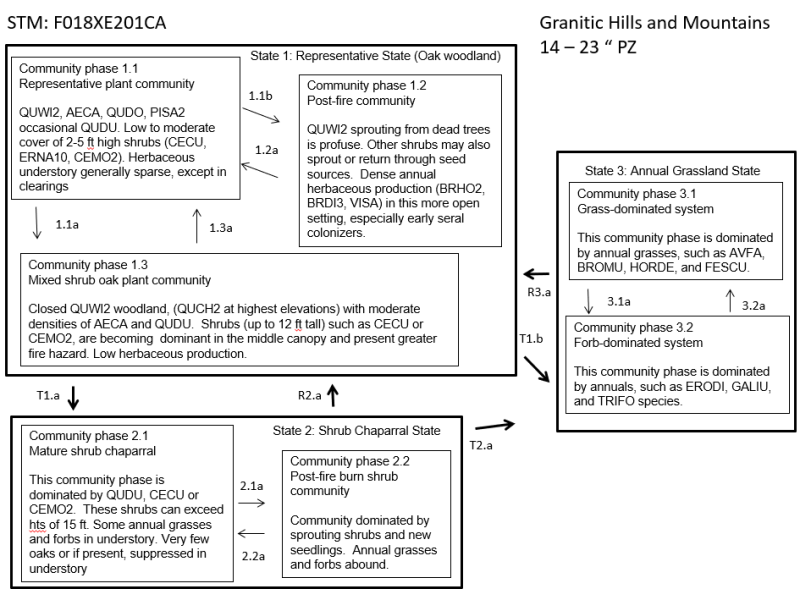
Natural Resources
Conservation Service
Ecological site F018XE201CA
Granitic Hills and Mountains
Last updated: 4/24/2024
Accessed: 12/21/2025
General information
Provisional. A provisional ecological site description has undergone quality control and quality assurance review. It contains a working state and transition model and enough information to identify the ecological site.
MLRA notes
Major Land Resource Area (MLRA): 018X–Sierra Nevada Foothills
Major Land Resource Area (MLRA): 018X–Sierra Nevada Foothills
Major Land Resource Area (MLRA) 18, Sierra Nevada Foothills is located entirely in California and runs north to south adjacent to and down-slope of the Sierra Nevada Mountains (MLRA 22A). MLRA 18 includes rolling to steep dissected hills and low mountains, with several very steep river valleys. Climate is distinctively Mediterranean (xeric soil moisture regime) with hot, dry summers, and relatively cool, wet winters. Most of the precipitation comes as rain; average annual precipitation ranges from 15 to 55 inches in most of the area (precipitation generally increases with elevation and from south to north). Soil temperature regime is thermic; mean annual air temperature generally ranges between 52 and 64 degrees F. Geology is rather complex in this region; there were several volcanic flow and ashfall events, as well as tectonic uplift, during the past 25 million years that contributed to the current landscape.
LRU notes
LRU 18XE is located on moderate to steep mountains and hills in the Tehachapi Foothills east of Bakersfield. This LRU covers the lower slopes around the southern end of the Greenhorn Mountains, the western sides of Breckenridge Mountain and the Tehachapi Mountains. The elevation ranges from 500 to 6500 feet above sea level and the geology of the region is predominately granitoid (both unaltered and metamorphosed). Similar to LRU 18XC to the north, vegetation series include blue oak, needlegrass and annual grasslands, as well as chamise, ceanothus, mixed oaks, and foothill pine, although this LRU tends to be more arid than with an annual precipitation range of only 8 to 31 inches per year. The lower precipitation and higher evaporative losses mean that these soils may not be able to completely leach excess salts, leading to a build-up of calcium and/or sodium in the subsoil. The soil temperature regime in this LRU is thermic and the soil moisture regimes are both xeric and aridic.
Classification relationships
CLASSIFICATION RELATIONSHIPS
This site is located within M261F, the Sierra Nevada Foothills Section, (McNab et al., 2007) of the National Hierarchical Framework of Ecological Units (Cleland et al., 1997), M261Fb, the Lower Foothills Metamorphic Belt Subsection.
Level III and Level IV ecoregions systems (Omernik, 1987, and EPA, 2011) are: Level III, Central California Foothills and Coastal Mountains and Level IV, Ecoregion 6ae, Tehachapi Foothills.
Ecological site concept
This site is characterized by shallow to deep soils occurring on steep hills and mountains formed from granitic or schist parent material. Slopes typically range from 10 to 63%. Annual precipitation typically ranges from 12 to 17 inches per year. Elevation typically ranges from 3600 to 5000 feet. Generally, this concept occurs at the interface between thermic and mesic soil temperature regimes; this site generally occurs at the interface between the thermic and mesic areas, and it includes both cool thermic and warm mesic areas.
The main drivers of plant communities in this site (relative to the ecological sites found at lower elevations) are the high available water capacity associated with the deeper soils, and cooler soil temperatures associated with borderline mesic soil temperature regimes. These conditions support closed-canopy oak woodlands with a high diversity of trees and shrubs. Common soil series correlated to this ecological site include Tweedy (Fine-loamy, mixed, superactive, mesic Typic Argixerolls), Edmundston (Coarse-loamy, mixed, superactive, mesic Pachic Haploxerolls) and Sorrell (Coarse-loamy, mixed, superactive, mesic Typic Argixerolls)
Vegetation includes closed oak woodland with interior live oak (Quercus wislizeni), California buckeye (Aesculus californica), California foothill pine (Pinus sabiniana) and blue oak (Quercus douglasii). Buckbrush (Ceanothus cuneatus), rubber rabbitbrush (Ericameria nauseosa), and alderleaf mahogany (Cercocarpus montanus) are common shrubs in the understory. Herbaceous plants such as soft chess (Bromus hordeaceus), cheatgrass (Bromus tectorum), blue grass (Poa spp.), and California buckwheat (Eriogonum fasciculatum) may occur in the understory, especially where there are canopy gaps, but herbaceous production is low (1000 to 2000 lbs per acre) due to low amounts of sunlight penetrating to the woodland floor. Understory production may be higher at the low end of the elevation range for this site where the canopy cover is more open.
Associated sites
| F022AW003CA |
Shallow Mesic Mountains <40"ppt This site commonly occurs nearby. |
|---|
Table 1. Dominant plant species
| Tree |
(1) Quercus wislizeni |
|---|---|
| Shrub |
(1) Ceanothus cuneatus |
| Herbaceous |
(1) Bromus hordeaceus |
Click on box and path labels to scroll to the respective text.

